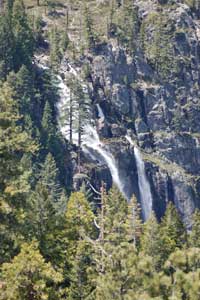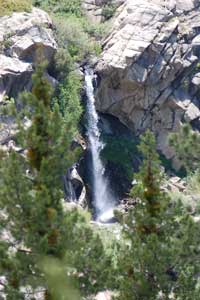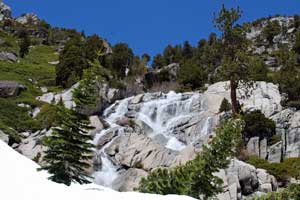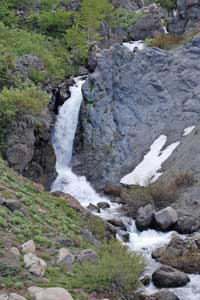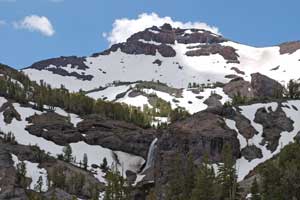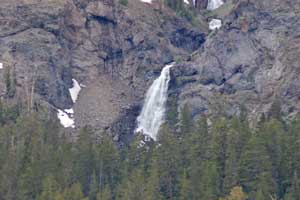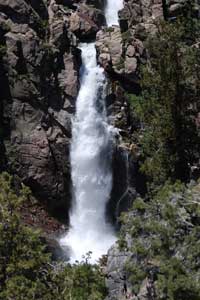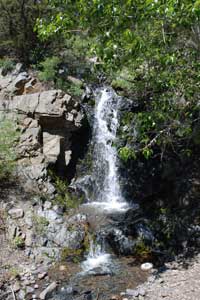Natural Wonders of Sonora Pass
Geologic Wonders, Ancient Trees, Scenic Overlooks, Waterfalls
Geologic Wonders
Columns of the Giants
One of the most interesting of the natural wonders of Sonora Pass is along the Columns of the Giants Trail located next to the Pigeon Flat Campground about 1½ miles east of Dardanelle Resort. The trail provides an easy quarter mile walk to an unusual geologic formation with views of basalt columns, reminiscent of the Devil's Postpile. The Columns of the Giants are columnar hexagonal basalt rocks polished during ice ages.
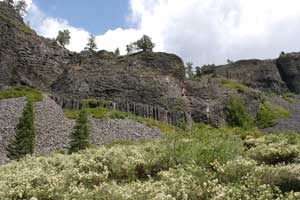
The Columns of the Giants were created when molten lava flowed into an ancient riverbed and collected behind a natural dam. As it cooled, it hardened and shrank, splitting into multi-sided, vertical columns.
Trail of the Gargoyles

Another of the natural wonders of Sonora Pass is found by taking the 1½-mile trail to strangely shaped volcanic rock formations which the Stanislaus National Forest calls Trail of the Gargoyles. You can pick up a pamphlet describing the trail at the Summit Ranger Station at the Y near Pinecrest. To reach the Trail of the Gargoyles drive east from Strawberry to the Herring Creek Road turnoff on your right. Follow it 6 miles (the last few miles are on dirt road) to an unmarked, dirt road turnoff to the left. A sign says No Camping Beyond This Point. Follow that short, slightly bumpy road to the edge of the canyon.
Trails leading off in either direction along the rim of the canyon offer spectacular views of a canyon walls and mountains in the distance. The trails do not form a loop. All along the cliff's edge are wondrous formations of volcanic rock that has eroded into strange shapes. Among the features are an ancient river bed, granite erratics (boulders left behind by the retreating ice), basalt columns, and the Wall of Noses.
Caution should be used because the crumbling cliff's edge could be dangerous to approach.
David Alt's Roadside Geology series has long been the best guides available for anyone interested in learning more about California's geology. This updated version, written with Donald W. Hyndman, has expanded coverage along with new photos and maps. In includes Lake Tahoe, Yosemite National Park, Lassen Volcanic National Park, Lava Beds National Monument, Kings Canyon National Park, and much more.
Ancient Trees
Bennett Juniper
Among the most well-known of the natural wonders of Sonora Pass is the 3,000-year-old Bennett Juniper, the largest western juniper in existence. The Bennett Juniper is at 8,400 feet elevation in Eagle Meadow. Drive east about 14 miles from Strawberry and turn right onto the Eagle Meadow Road. Usually the road is open by mid-June and remains open through October. There are two significant creek crossings (Eagle and Long Valley) that might be difficult for vehicles without high clearance early in the season. Usually by August the creeks are low enough for most vehicles to cross. It is a 13-mile drive from Highway 108, but it takes about an hour to drive.
The Bennett Juniper has a diameter of 13 feet and a height of 86 feet. Its branches are twisted and gnarled, making it a popular subject for photography.
Trail of the Survivors
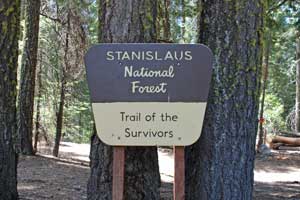
The Trail of the Survivors is a short loop with interpretive signs explaining how the trees of the forest have survived through fires and other hardships. To find the trail from Pinecrest, drive up the Dodge Ridge Road a short distance and turn right on the road to Camp Gold. Immediately after turning onto the road look for the sign marking the beginning of the trail on your left.
Trail of the Ancient Dwarfs
The Trail of the Ancient Dwarfs is a half-mile walk through a forest of ancient dwarf trees. A visit to the Trail of the Ancient Dwarfs is best coupled with a view of the ancient Bennett Juniper as they are both near Eagle Meadow. Drive about 15 miles east of Pinecrest on Hwy. 108 to Eagle Meadow Road on your right. Stay left when Eagle Meadow Road forks to the right. Follow Forest Service Road 5N24 past Niagara Creek Campground and park in turnoff near a blocked-off bridge. The parking area is seven-tenths of a mile from Highway 108. Brochures are available in the trail register box. At an elevation of 6,600 feet, the half-mile trail overlooks the Middle Fork of the Stanislaus River Canyon and hikers even get glimpses of Highway 108 below. Part of the trail follows the historic Sonora and Mono Wagon Road.
Scenic Overlooks
Dodge Ridge Overlook
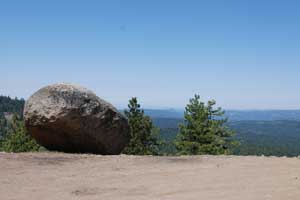
This unofficial overlook is known well to locals as a wonderful place to watch the sunset. From a high, clear point on Dodge Ridge, near the Aspen Meadow Pack Station and only a few miles from Pinecrest, the overlook affords a panoramic view to the west. Prominent in the distance is the deep Stanislaus River Canyon. On evenings with scattered clouds the sunsets are spectacular.
To reach the Dodge Ridge Overlook, drive up the Crabtree Road (either from near Cold Springs or by going up the Dodge Ridge Road out of Pinecrest and using the cross-over road just before the ski resort). Follow the Crabtree Road up to the top of the hill (4.8 miles from Pinecrest). Take the first dirt road on your right (before the pack station) and follow it up 100 yards to a flat turn-around/parking area.
Stanislaus River Canyon Overlook
Although not an official scenic viewpoint, the small turnout 2 miles east of Strawberry on the north side of Highway 108 offers a broad vista of the Stanislaus River Canyon. Directly below, although probably out of sight from most vantage points, rests Beardsley Reservoir. In the distance to the northwest is Big Trees State Park.
Donnell Vista
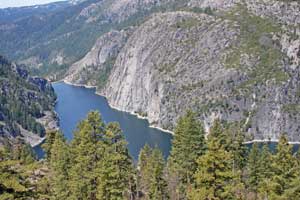
Donnell Vista overlooks Donnell Reservoir, a spectacular lake set in a deep canyon with steep granite walls. The Donnell Vista is located on Highway 108 approximately 45 miles east of Sonora. A short trail leads down to a railed viewing area which provides views of the reservoir, the Dardanelles Cones, and the Middle Fork of the Stanislaus River. Restrooms are also located here.
An interpretive sign recalls a Gold Rush-era skirmish between Indians and workers for the Columbia and Stanislaus River Water Company. Miners constructed a ditch from what was then called Donnell Flat to Columbia to provide water for mining operations.
Que de Porka Overlook
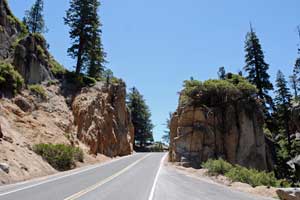
One mile east of the Kennedy Meadows turnoff on Highway 108 is Que de Porka, a narrow divide in the rock where the road slips through. Immediately on the other side is a turnout. From this vantage point you can look southwest past Relief Reservoir at up to the Emigrant Wilderness. Snow often lingers on the peaks into the summer. It was through this area that the 1852-1854 emigrants brought their wagons along the Walker River Emigrant Trail on their way to Sonora.
Deadman Creek Overlook
A similar view to the Que de Porka overlook can be appreciated from a more developed overlook a mile farther east on the road where there is better parking and the Forest Service has installed interpretive signs.
Sonora and Mono Road Turnout
Five miles east of the Kennedy Meadows Road on Highway 108 is a paved turnout along the side of Deadman Creek. Across the creek can be seen remnants of the old Sonora and Mono Wagon Road, opening in 1864.
Sonora Pass Summit
The top of Sonora Pass provides spectacular views eastward into Mono County and back across the crest of the Sierra. Just before you reach the summit of Sonora Pass there is a turnoff to picnic area with vault restrooms. You can park there to explore the summit of Sonora Pass, or you can find ample parking along the shoulder of the road right at the top of the pass. Signs there tell of the pass's discovery. The Pacific Crest Trail crosses Highway 108 there. Walks in either direction offer views of the surrounding country.
Leavitt Meadow Overview
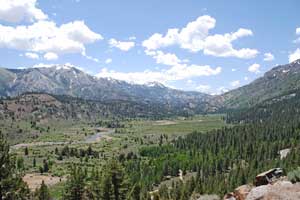
The unofficial Leavitt Meadow overview point is a wonderful place to look out across Leavitt Meadow and up toward the high Sierra. Magnificent Tower Peak on the northeastern boundary of Yosemite National Park rises on the skyline. The parking area is 6 miles east of Sonora Pass, just before you make an obvious hairpin turn to begin the final descent to Leavitt Meadow.
During the 1850s emigrants brought their wagons into the upper end of Leavitt Meadow from near Poore Lake and then forged a difficult trail up a narrow canyon at head of the meadow. Their route eventually led them north of Tower Peak and down the canyons and ridges to Dodge Ridge and Pinecrest.

